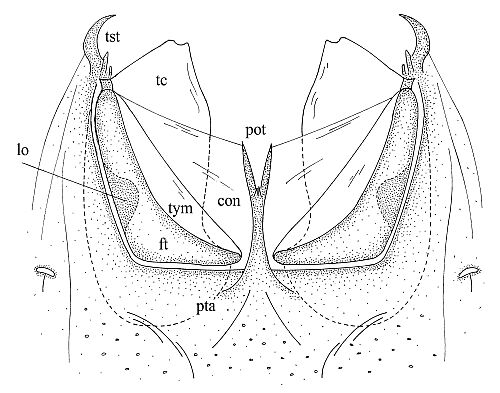
Pyraloidea
By the end of 2022, the Pyraloidea comprise 16,723 described species worldwide, and probably as many more remain to be described. Among all Lepidoptera, pyraloids show the most diverse life history adaptations. The larvae of most species feed on living plants either internally or externally as leaf rollers, leaf webbers leaf miners, borers, root feeders, and seed feeders. Some species live parasitically in ant nests (Wurthiinae spp.), predate upon scale insects (certain Phycitinae spp.), or live in the nests of bees (Galleriinae spp.). The larvae of the Acentropinae are adapted to life under water, and certain Phycitinae and Pyralinae are adapted to very dry environments and their larvae feed on stored food products. Others feed on animal detritus. With such a variety of living habits, pyraloids are an ideal group for biodiversity studies (Schulze 2000; Nuss 2000). Some species are of economic importance, e.g. rice stem borers (Chilo spp., Scirpophaga spp.), sod grass webworms (different species of Crambinae), Indian meal moth (Plodia interpunctella), European corn borer (Ostrinia nubilalis), Indo-Australian coconut spike moth (Tirathaba rufivena), Cacao moth (Ephestia elutella), Mediterranean flour moth (Ephestia kuehniella), wax moths (Achroia grisella, Galleria mellonella), and rice moth (Corcyra cephalonica).
How to recognize a pyraloid moth?
The wing span of pyraloid moths varies from less than 10 mm to more than 80 mm. The head bears long and porrect or upturned labial palpi. The maxillary palpi are generally present. The main external characters supporting the monophyly of the group are the basally scaled proboscis and the paired tympanal organs situated ventrally on the 2nd abdominal segment.
Tympanal organs enable moths to detect the ultrasounds of insectivorous bats. Many superfamilies within the obtectomeran Lepidoptera (the groups with obtect pupae) have tympanal organs, but they are not homologous. Only Geometroidea have tympanal organs which are also situated on the 2nd abdominal segment, but they are distinct in structure and evolved independently. It is generally accepted that Lepidopteran tympanal organs co-evolved with the sonar system of bats. In Achroia grisella and Galleria mellonella (Pyralidae, Galleriinae), the moths also possess tymbal organs on the tegulae to produce ultrasound for intraspecific, accoustic communication.
Systematics of the PyraloideaThere are two main types of tympanal organs within Pyraloidea, indicating two distinct evolutionary lineages: the Pyralidae Latreille, 1809 (or Pyraliformes) and Crambidae Latreille, 1810 (or Crambiformes) (Munroe 1972, Minet 1982, Maes 1985, Munroe & Solis 1999). This basal dichotomy in pyraloid phylogeny is supported by molecular data (Regier et al. 2012). The following table shows the main diagnostic characters to identify these two groups. |
|
Pyralidae
|
Crambidae
|
|
Tympanal organ: Sketch and SEM-photograph of tympanal organs of pyraloid type. Ventral view of the tympanal organs of Scoparia pyralella (line drawing). con - conjunctivum., ft - fornix tympani, lo – lobulus, pot - pons tympani, pta – post tympanal area, tc – tympanal case, tst - tergo-sternal sclerite, tym - tympanum (drawing M. Nuss). References for the cited literature can be obtained via -> database -> search. Last updated: April 10, 2023 |
|
